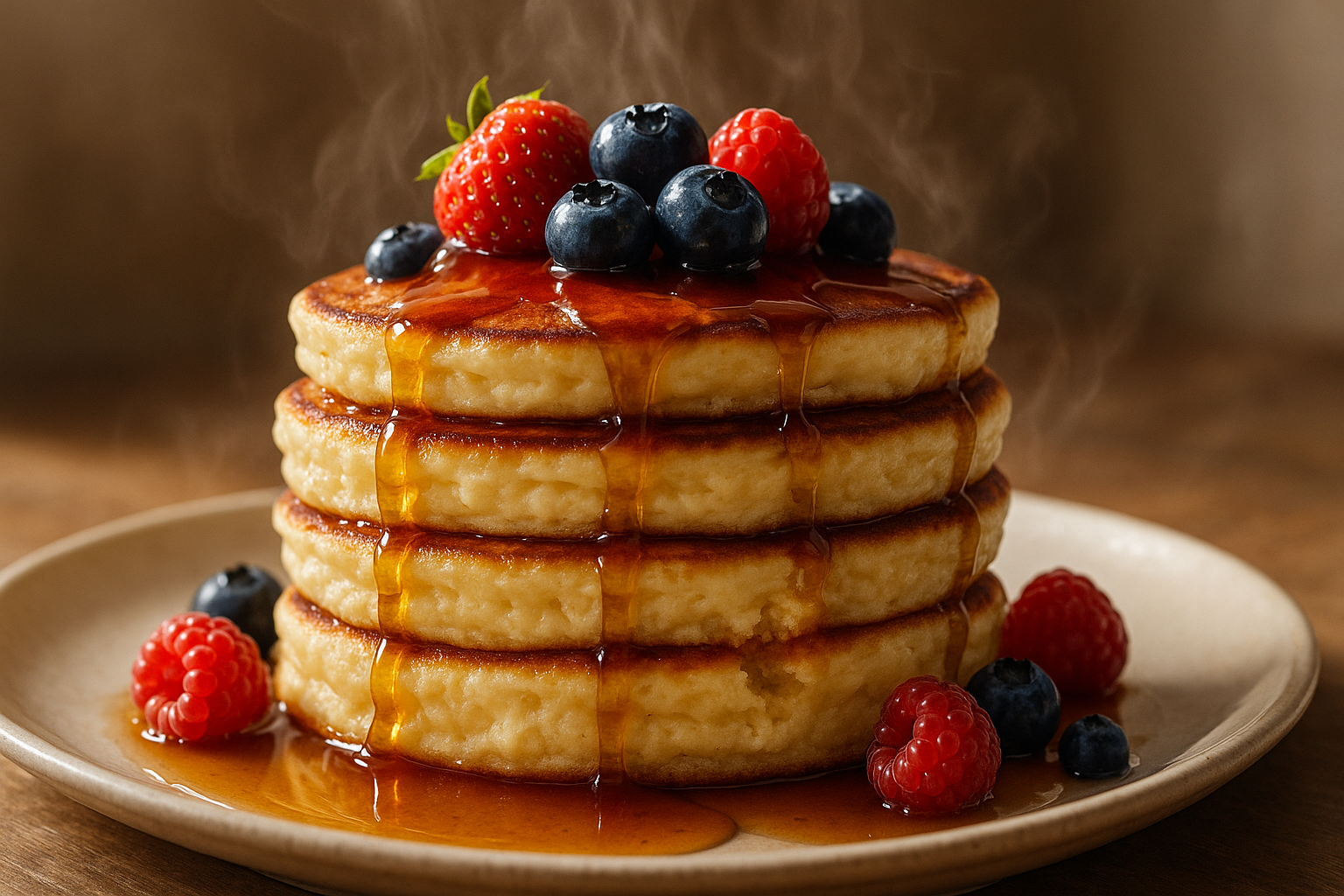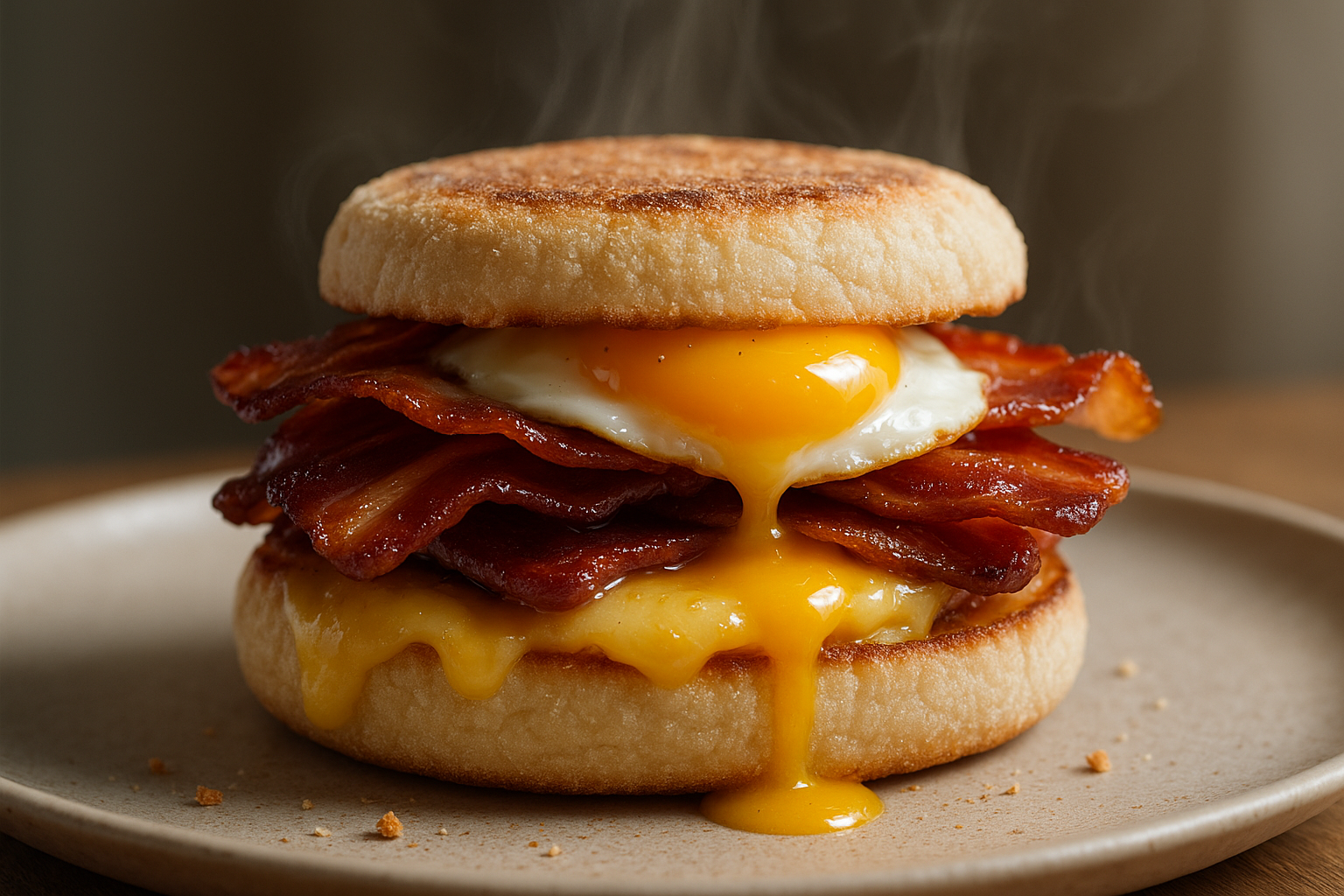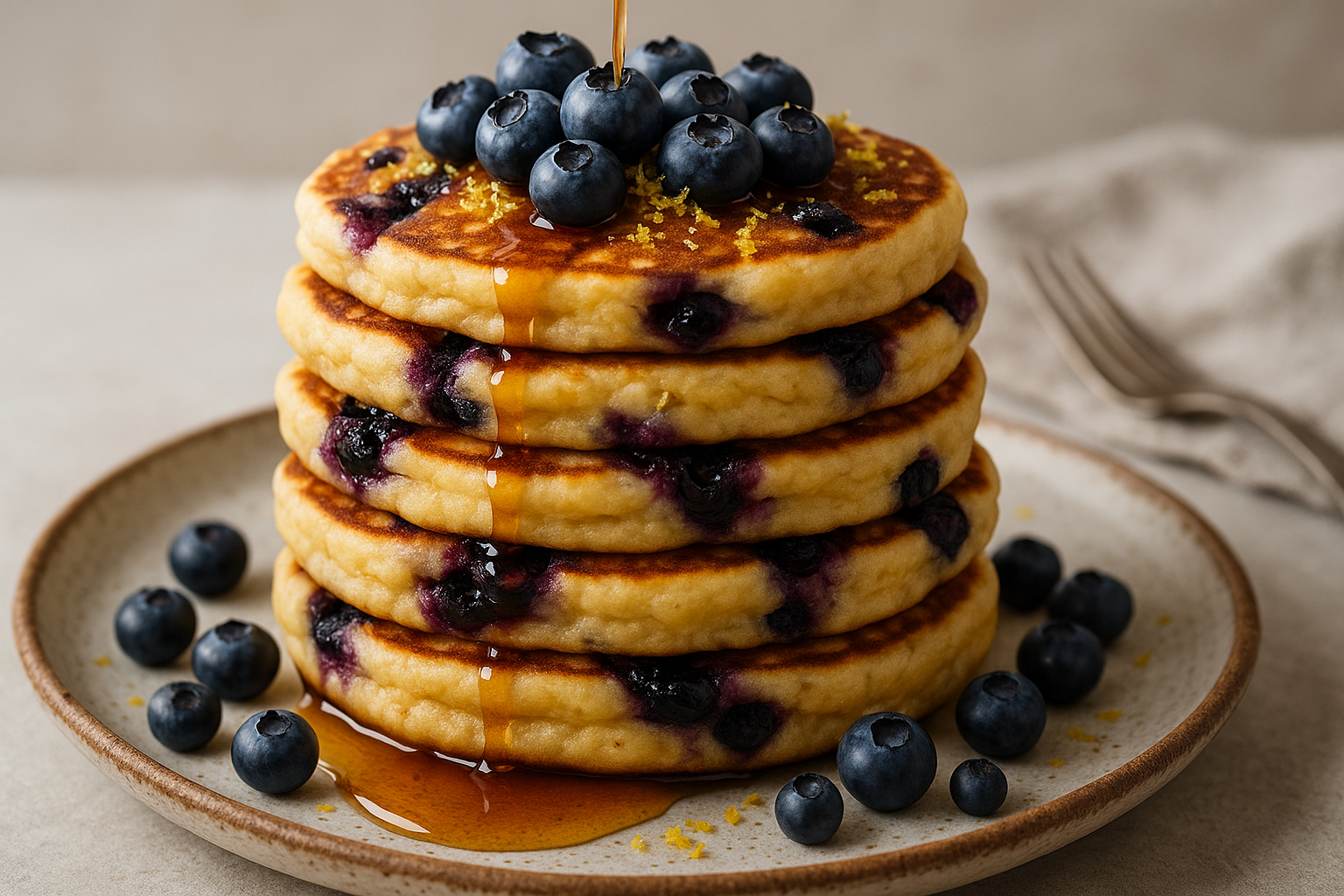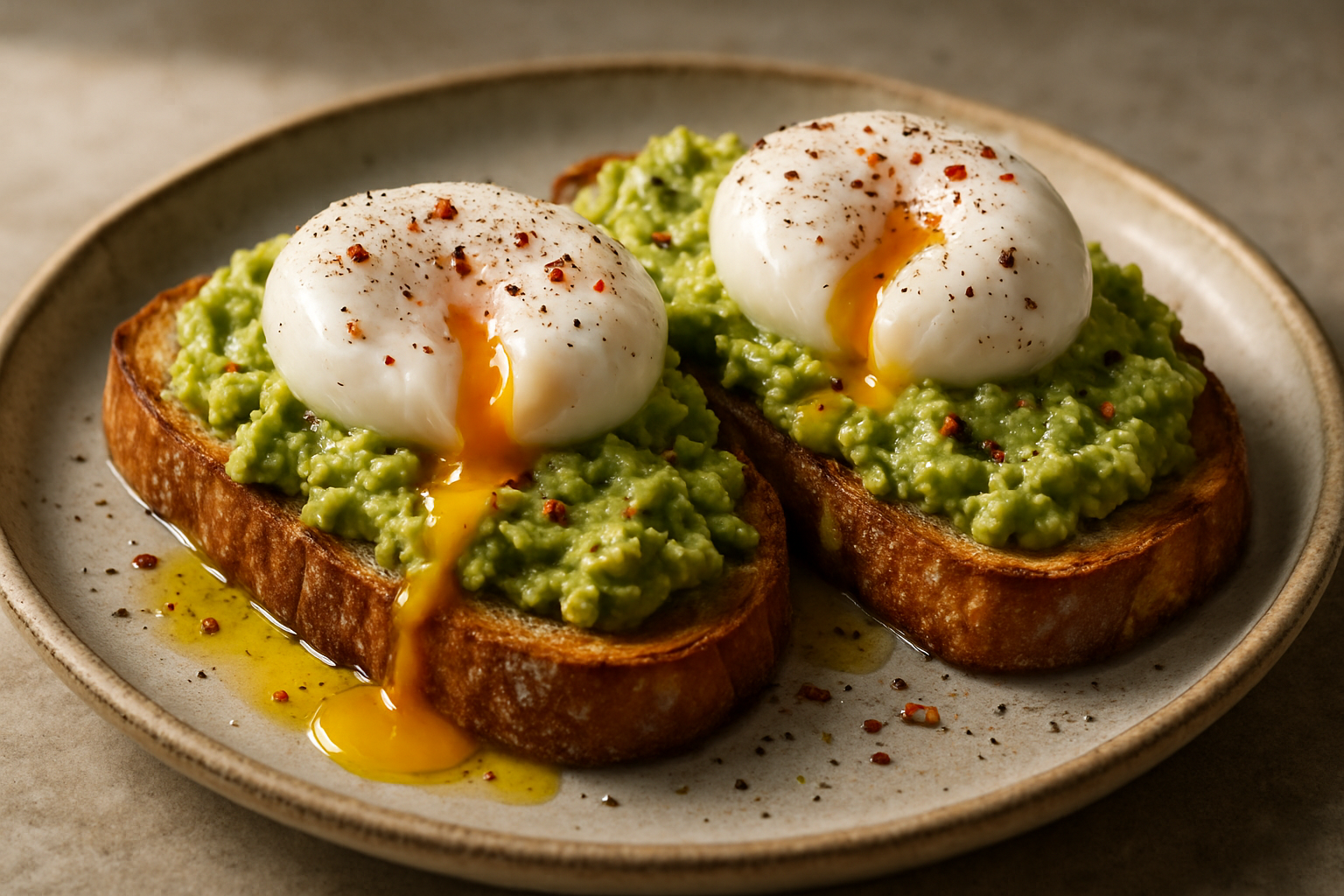These aren’t your average pancakes. These are fat, golden, cloud-soft ricotta stacks that eat like cheesecake for breakfast. They’re creamy, thick, and rich — the kind of pancakes you bite into and instantly wonder why all others bother. Lightened with whipped egg white, scented with vanilla, and crowned with fresh berries and hot maple syrup, this is a proper indulgence. Whether you’re nursing a hangover, treating someone special, or feeding your inner child — this stack doesn’t whisper. It seduces.
Ingredients
Serves 2 (makes around 6 pancakes)
125g ricotta cheese 1 egg, separated 100ml whole milk 1 tsp vanilla extract 75g plain flour 1 tsp baking powder Pinch of fine sea salt Butter, for frying Fresh berries (blueberries, raspberries, strawberries), to serve Warm maple syrup, to serve
Equipment needed
2 mixing bowls Whisk Sieve Spatula Measuring jug Non-stick frying pan Small ladle or tablespoon Plate for stacking
Step-by-step method
1. Separate and prep.
Crack the egg and separate the white and yolk into two bowls. In the bowl with the yolk, add the ricotta and mash it slightly with a fork to loosen it up.
2. Make the base batter.
Add the whole milk and vanilla extract to the ricotta and egg yolk. Whisk until smooth and creamy. Sift in the plain flour, baking powder, and salt. Mix gently until just combined — don’t overwork it. The batter will be thick.
3. Whip the egg white.
Whisk the egg white in the second bowl until it forms soft peaks — it should hold shape but still flop at the tip. This is what gives the pancakes their lift.
4. Fold it in.
Use a spatula to gently fold the whipped egg white into the thick batter in two stages. Don’t stir — fold gently to preserve air. The finished batter should be pale, fluffy, and airy.
5. Heat the pan.
Place a non-stick frying pan over medium heat. Add a small knob of butter and swirl to coat the surface. When it sizzles but doesn’t burn, you’re ready to cook.
6. Cook the pancakes.
Spoon in the batter to form small rounds — about 2 tablespoons each. Leave space between them. Cook for 2 minutes or until the bottoms are golden and bubbles start to appear on top. Flip carefully with a spatula.
7. Finish the flip.
Cook for another 90 seconds on the second side until golden and puffed. Remove and stack them on a warm plate while you repeat with the rest of the batter, adding a little butter each time.
8. Serve and dress.
Top the warm pancake stack with a handful of fresh berries. Drizzle generously with warm maple syrup and serve immediately.
Serving tips
Serve these pancakes stacked high with warm syrup trickling down the sides. Add a dollop of whipped cream or Greek yoghurt for extra indulgence. A scattering of toasted nuts or dark chocolate chips takes this to dessert territory. Want something sharper? Spoon over a berry compote or crushed raspberries with lemon juice.
Chef’s notes
Ricotta matters. Use full-fat ricotta and drain off excess liquid before using. The thicker the ricotta, the creamier your pancake interior.
Egg white technique. Don’t skip whipping the egg white. That’s what keeps these light. Fold slowly and stop as soon as it’s incorporated — overmixing knocks the air out.
Pan control. Too hot and the outside will burn before the centre cooks. Keep it medium and patient — that’s how you get the soft-set centre and golden crust.
Batch trick. Keep cooked pancakes warm on a baking tray in a low oven (100°C fan) while you finish the rest. No stress, no cold stacks.
Syrup upgrade. Warm your maple syrup before pouring. Cold syrup seizes the pancakes and dulls the texture. A few seconds in the microwave or in a small pan does the job.
Fruit swaps. Blueberries, raspberries, strawberries — all work. Add sliced banana and a dusting of cinnamon for a richer, sweeter variation. Or go full luxury with poached pears and honey.
Final thought
These aren’t quick grab-and-go pancakes. They’re special. They’re soft, melting, and completely over the top in all the right ways. They don’t apologise for being rich or creamy or slow. They’re here to seduce — and they do. Cheesecake for breakfast? You’re damn right.
Health stats (per serving)
Each serving comes in at around 1,980kJ (470kcal), with 22g fat, 11g saturates, 10g sugars, and 0.8g salt. Expect roughly 14g protein, 38g carbohydrates, and 2g fibre — indulgent, satisfying, and worthy of a weekend.
Disclaimer
Every effort has been made to ensure the accuracy and clarity of this recipe. However, all individuals are responsible for verifying the ingredients, techniques, and methods they use. Always check packaging labels for the most up-to-date information regarding allergens, cross-contamination risks, and suitability for specific dietary needs, including gluten-free, nut-free, dairy-free, vegetarian, or vegan requirements.
Nutritional information provided is estimated for guidance only and may vary depending on portion size, specific brands, or substitutions used. It should not be relied upon as medical or nutritional advice. If you have any allergies, intolerances, medical conditions, or dietary concerns, consult a qualified health professional before preparing or consuming any recipe on this site.
By following this recipe, you acknowledge that you do so at your own risk. The site, its writers, and contributors are not liable for any adverse reactions, ingredient misinterpretations, or accidents in the preparation or consumption of any dishes.
For full details, please refer to the site’s complete disclaimer and terms of use.



